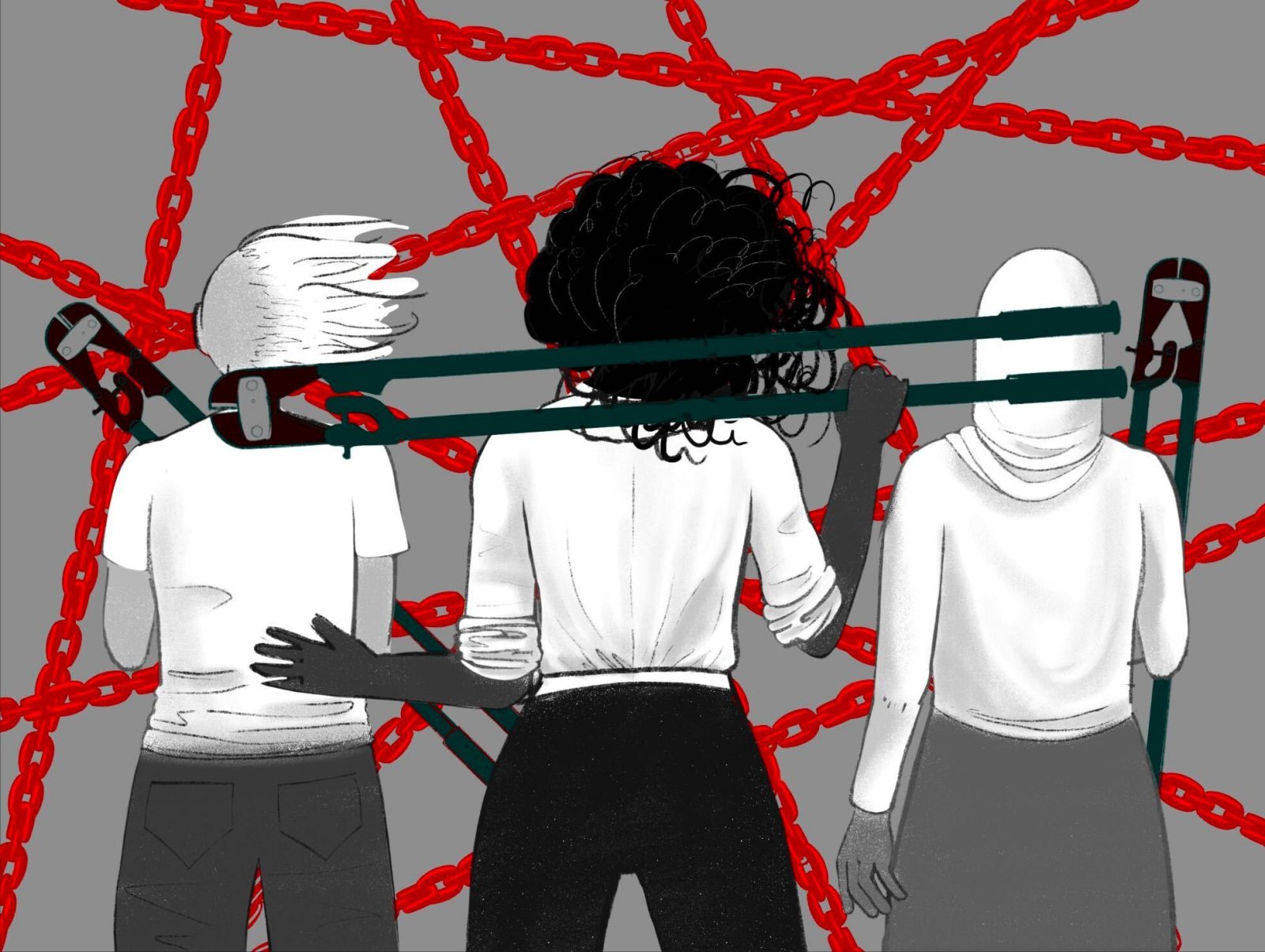In Republican-controlled regions across the country, people are engaged in abolitionist organizing: Even though conditions vary, people are organizing for freedom virtually everywhere. This is nothing new. The South, for example, has been a site for abolitionist organizing for centuries, and it continues to be one, despite the attacks on long-settled civil rights being organized by Republican supermajorities in statehouses.
Ash-Lee Woodard Henderson is the first Black woman to codirect the Highlander Research and Education Center, a century-old nexus for abolitionist and labor organizing in Tennessee and beyond. She is also a cofounder of the Movement for Black Lives. Woodard Henderson says that if abolitionists really believe the most impacted and marginalized people are at the heart of the struggle, then red states and counties must be centered in organizing efforts instead of treated as lost causes. She notes that the South in particular is often ceded by national organizations—which, among other problems, makes it hard for organizations working in the region to secure funding from philanthropic foundations.

From the series
Abolition in Action
A collection of essays exploring how people are practicing abolition in their communities, in partnership with Truthout.
The sense of these places being lost causes is not only offensive, it’s deeply untrue. In fact, decarceral groups in red states and counties are seeing success even amid what many organizers identify as a fascist turn in politics nationally. For example, Florida Prisoner Solidarity, an abolitionist collective based in Gainesville that has members inside and outside of prison across the state, won a campaign earlier this year to make phone calls from the jail in Alachua County free and unlimited (down from a cost of $.21 per minute).
These efforts do not generally achieve the same visibility as those in blue states and so-called liberal areas—but this doesn’t make them less critical to abolitionist struggle. “Don’t give up on us,” asks aurelius francisco, co–executive director of The Foundation for Liberating Minds in Oklahoma City. “We’ve always resisted . . . and we’ll continue to do so.”
Organizers in red states and counties are bringing abolitionist struggle to their communities, in the process highlighting how their strategies seek to draw in people who might not normally see themselves as allied to “liberal” causes. This is a lesson that can be valuable to organizers throughout the country who are seeking new ways of growing solidarity.
More from our decarceral brainstorm
Every week, Inquest aims to bring you insights from people thinking through and working for a world without mass incarceration.
Sign up for our newsletter for the latest.
Newsletter
It’s critical to be clear about the dynamic at play in red states. Woodard Henderson highlights that it isn’t that all residents of these places are conservative—but their elected politicians are, and have successfully engineered their way to power through gerrymandering and voter suppression. Furthermore, it is often too easy to overstate the difference between these places and places conventionally thought of as liberal—but it isn’t as if the neoliberals who run city governments in New York or Chicago are pro-abolition.
The organizers I spoke with stressed that building relationships is paramount everywhere in working toward abolition, but perhaps more so in conservative areas. Moreover, forming these relationships necessarily takes a different form. This often means having to work with people whom abolitionists may generally disagree with or dislike. Mauve Perle Tahat, a scholar and organizer located in rural Pennsylvania, said that, where they are, it isn’t possible to build radical community through a reactive approach: “We can’t organize by saying, ‘Oh, that guy, he’s just an idiot.’” Instead, Tahat said, abolitionists must embrace the idea that “nobody is better than the other.”
Cam Calisch is an organizer from the South and cofounder of Study and Struggle, an abolitionist collective that organizes political education study groups and other forms of support throughout the Mississippi prison system. A major part of Calisch’s abolitionist work is simply building relationships with their neighbors in Water Valley, a town in Mississippi with a population of 3,300 people. While people new to organizing sometimes have the idea that it has to be a big thing, like starting an organization or event, Calisch said that “being in Water Valley really cemented how untrue that is, and how [abolitionist organizing] is really just the relationships that we hold in our everyday life.”
Although Calisch doesn’t necessarily discuss abolition with next-door neighbors, their relationships with these neighbors, built on mutual interdependence, still serve as building blocks toward more explicit abolitionist networks of care. Calisch notes, it “isn’t going to look like hyper-visible rallies or antagonistic protests, like it can in bigger cities (and where it should look like that because that’s a really effective tactic).”
Instead, they say, in a small town, building toward abolition looks like spending time together, sharing food and “having intimate conversations about how you would protect each other. Like, when an ice storm hits, how are we going to share resources?” People in rural areas in particular already feel disenfranchised, and so the idea that “no one is coming to save us”—and that therefore people need to build alternative networks of care and safety—is “very intuitive,” said Calisch. And this relationship-building in turn allows them to pursue more overtly abolitionist goals, such as distributing resources inside prisons and creating infrastructure outside of the police.
The picture is not all rosy, however. Activists I spoke with noted that being in a small town or place without obvious organizing hubs can be isolating.
Kasey Rhone, a cofounder of the Tulsa Intersectional Care Network, is organizing an online abolitionist study group with francisco with the goal of bringing people into the work. Rhone said that she knows one barrier is loneliness. But, she said, “No one’s alone. Anybody doing this work, you’re not alone.”
This sense of isolation can take a personal toll, especially when exacerbated by the blizzards of hateful bills being pushed by Republican legislatures in places such as Oklahoma, Texas, and Florida. It’s easy for organizers to burn out when there are so many crises happening simultaneously. francisco highlights how these circumstances put the movement in a position of “constantly reacting,” making it particularly hard—perhaps by design—to build the necessary relationships and to create space to imagine a future free of policing in all its forms.
Organizers with Florida Prisoner Solidarity expressed feeling worn down by the combination of increasing hostility toward trans and queer people, the attacks on anti-racism (and therefore on people of color), and other onslaughts led by the DeSantis administration. This is worsened by the fact that organizers often belong to communities targeted by conservative culture wars. Exhausting, too, is the lack of visibility of people in prison and how they are being impacted, even in political spaces that are devoted, for example, to queer and trans community-building. On top of all this, Florida recently called in the National Guard to staff its prisons. This has brought worsened censorship and book banning, long already prevalent in the Florida prison system, say organizers.
Indeed, a theme in many conversations was that red state prisons’ administrative cruelty and dysfunction can itself drag down organizers trying to work in, through, and against them. In Mississippi Calisch describes a prison system that is some combination of unable and unwilling to even hand out reading materials that are donated or sent through the mail. Books often sit for weeks or are thrown away and, in response to questions, administrators have told Study and Struggle to call ahead and see if someone can receive books. (It is unconstitutional to require people to get permission before receiving books in prison.)
Liliana Castrillón, a Houston organizer with Texas Abolitionists, has been visiting people on death row for eighteen years, providing friendship and support. In the visiting room, she has seen little girls showing off their dresses to a father or big brother while guards mocked them. It is not easy work, Castrillón says. “It’s scary emotionally. You’re always thinking, is he gonna get [an execution] date?”
For Castrillón, something that sets Houston apart is its longstanding normalization of state violence. Texas has carried out the most executions of any state since the death penalty’s reinstatement in 1976. Most recently, Texas prisons have made headlines because of the deadly heat inside prisons without air conditioning, where they have simultaneously raised the price of water.
In Texas the murder of a “peace officer” (law enforcement officer or prison guard), on or off duty, is a capital offense. In some of these cases, Castrillón has witnessed cops having actual parties, akin to a tailgate, right outside of executions, in an area that families and other witnesses must walk through to enter the building. Anti–death penalty protesters, by contrast, are kept at some distance. Very little information on death row conditions is shared in public forums because local journalists have been conditioned to accept this situation as normal. “The worst thing that can happen to a country, to a people, is to get used to the violence,” said Castrillón, who emigrated from Colombia after her hometown became dangerous. “Once you get used to the violence and the pain, you become immune, and then you don’t care.”
Organizing in red areas can also come with unique personal risks for organizers.
Visibility carries risks that can make organizers in rural areas especially vulnerable. On one occasion, for example, a friend of Calisch’s came to live in Water Valley after his release from incarceration. That friend, a Black man, was soon targeted by the town’s white police chief. “Once he was targeted,” Calisch said, “there was no way out.”
Calisch also described being doxxed by a group of neo-Confederates while living in another part of Mississippi. For a while, they said, they felt like they were either “going to die by doing the work or someone was gonna kill me.” Calisch moved soon after, and said they do not necessarily introduce themself as political or as an abolitionist in Water Valley.
Even though she is based in a large city, Castrillón said she too keeps a relatively low profile at protests—especially when she is coming in and out of the small towns outside of Houston she must pass through to get to the many prisons she visits, including the execution chamber in Huntsville. Castrillón describes making a stop once on the day of an execution and seeing a lunch special called “execution meal.” In order to avoid contact with people living around the prison, she makes sure that she has gas in her car so she won’t need to make a local stop in these “racist, hostile places.” Castrillón’s precautions highlight the difficulties that family members, friends, and others face in small, conservative prison towns.
Others interviewed for this story were concerned about negative repercussions at their jobs, including some who work at universities and who have already faced pressure from colleagues or superiors around their activism.
It’s important to recognize the shared and connected nature of work that’s happening in different places.
Texas Abolitionists is currently organizing events around Stop Cop City, a campaign against the proposed police training facility in Atlanta. Castrillón is quick to point out that Georgia is already the home of the School of the Americas: A sort of global Cop City, it’s a military training institute that has been responsible for training some of Latin America’s most violent right-wing military leaders.
Castrillón appealed for more solidarity from folks doing the work in places outside of Houston, especially places that may be less repressive or somewhat more open to this work. “We need your support. . . . Let us know you’re watching and get the word out,” she said, because “there are a lot of people trying to do the work in really, really harsh conditions.”
Ultimately, however, whatever the Republican supermajorities are doing won’t stymie the abolitionist movement, Woodard Henderson said. It’s still the job of abolitionists to organize a future and to “meet our people where they’re at with language that they use every day, to bring them along into their power that they already innately have, to actually change the societal structures that we inherited. I think when we do that, every time I’ve seen it done, it moves, and it moves regardless of if it’s a major city or holler in rural Appalachia.”
One example of this kind of organizing are two campaigns connected through the Southern Movement Assembly. In 2015 Project South organized a successful youth-led campaign, $10mil4real, that focused on shifting $10 million of the city’s education budget from cops to actual school improvements. To do this, activists surveyed other youth—those who were directly impacted by the allocation—to make a powerful statement about better ways to use that money, as well as raise consciousness about the money designated for education that is actually used for policing. Organizers in Letcher County, Kentucky, replicated this strategy to successfully stall the construction of a new federal prison. In both cases, commonsense responses from the community dovetailed with abolitionist values of creating community supports and resources that people need, rather than more police and prisons. (Inquest is published by the Institute to End Mass Incarceration, which is a member of the Building Community Not Prisons coalition working to stop the proposed construction of FCI Letcher County in Eastern Kentucky.)
Woodard Henderson said that one of the biggest struggles for abolitionists right now is for organizers to really believe in their own power to enact the world of abundance and safety that is a necessary part of an abolitionist future. The movement is currently experiencing a backlash because of its successes. “Coming off the intense grief and victories of 2020, we have to make a decision about if we’re going to put our foot on the gas and finish the game,” she said. “Or if we’re going to let an opposition who has for centuries lied to us about our worthiness, and about what is good for us, and what is possible in this country, tell us that.”
Header image: Thomas Cizauskas

